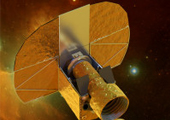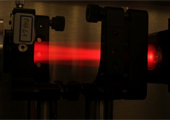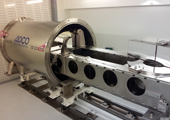 Astronomical Instrumentation and Surveys Astronomical Instrumentation and Surveys
CAUP participates in the scientific and technical development of Astronomical Instrumentation and dedicated observation Surveys, which transverses both major scientific areas in CAUP. The development of new instrumentations is important to secure privileged access to existing and future facilities of the European Organisation for Astronomical Research in the Southern Hemisphere (ESO) and of the European Space Agency (ESA). The participation of CAUP in large observation Surveys is also important to give direct acess to the available data in first hand. Both the involvement in instruments or in large Surveys contribute to the long term development of Astronomy in Portugal. CAUP as an institution and several CAUP members have been involved in the scientific definition of astronomical instrumentation and several projects that are already running in collaboration with other Portuguese teams. Here it is listed the several projects divided into the sections of Space based projects and Ground Based projects. Space projects Task Leader: Sérgio A. G. Sousa  Contact at CAUP: Nuno C. Santos  PLATO is an ESA mission (M3 slot), expected to be launched in 2024. The science case of PLATO will tackle several key scientific questions. These include the detection of terrestrial exoplanets in the habitable zone of solar-type stars and the characterization of their bulk properties needed to determine their habitability. In this context PLATO will allow to characterize thousands of rocky (including Earth twins), icy or giant planets, including the architecture of their planetary system, to fundamentally enhance our understanding of the formation and the evolution of planetary systems. These goals will be achieved through planet detection and radius determination (2% precision) from photometric transits, the determination of planet masses (better than 10% precision) from ground-based radial velocity follow-up, and the determination of accurate stellar masses, radii, and ages (10% precision) from asteroseismology. See also: Plato homepage  Contact at CAUP: Nuno C. Santos & Sérgio G. Sousa  The Characterising Exoplanet Satellite (CHEOPS) will be the first mission dedicated to search for transits of exoplanets by means of ultrahigh precision photometry on bright stars already known to host planets. It will provide the unique capability of determining accurate radii for a subset of those planets for which the mass has already been estimated from ground-based spectroscopic surveys. CHEOPS will also provide prime targets for future instruments suited to the spectroscopic characterisation of exoplanetary atmospheres. See also: CHEOPS homepage  Contact at CAUP: Mário J. P. F. G. Monteiro  This is a Discovery Program for detecting potentially life-supporting planets around other stars. Kepler is poised to find planets 30 to 600 times less Massive than Jupiter. Following the agreement between Denmark (Aarhus) and NASA, a Kepler Asteroseismic Science Consortium (KASC) has been created to take over the Asteroseismology component of this mission. CAUP participates in the KASC Steering Committee and the team is involved in the development of the seismic pipeline and exploitation of the seismic data. See also: KASC Scientific Webpage Kepler mission website  Contact at CAUP: António C. da Silva Euclid, a medium class space mission of the ESA Cosmic-Vision 2015-2020 programme and the successor of Planck as the next major cosmology mission, will be launched in 2020 and will stay in operation for 6 years mapping the extragalactic sky. Portugal is a full member of the Euclid Consortium since 2012, and the Portuguese participation, coordinated by CAUP, includes also CAAUL. Euclid will address some of the most compelling challenges in cosmology and fundamental physics, the most important of which is the understanding of the accelerated expansion of the universe and its effect on the growth of cosmic structures.
Ground Telescopes and Instrumentation Task Leader: Pedro Figueira  Contact at CAUP: Nuno C. Santos  According to the currently applicable E-ELT instrumentation plan E-ELT will offer a High Resolution Spectrograph as part of its suite of instruments soon after the first-light set of AO-modules and Scientific Instruments. The goal of the HIRES Initiative is to contribute to the definition of a sounded and disruptive science case for an High Resolution Spectrograph at the E-ELT and to define an instrument concept of proven feasibility to implement such a science case. See also: The HIRES website  Contact at CAUP: Nuno C. Santos  This spectrograph is under preparation by a consortium of 4 countries, in close collaboration with ESO. It is currently approved for instalation in the VLT. The Portuguese participation, coordinated by CAUP, also includes CAAUL. The key science goals of the consortium is to use this new-generation spectrograph to search for rocky extra-solar planets in the habitable zone and to determine the possible variability of physical constants. See also: Espresso mission website VLT website  Contact at CAUP: Sérgio A. G. Sousa  Gaia-ESO is a large public spectroscopic survey, targeting more that 100000 stars, systematically covering all major components of our galaxy, from halo to star forming regions, providing the first homogeneous overview of the distributions of kinematics and elemental abundances. This will substancially increase the knowledge of Galactic and stellar evolution. With the Gaia astrometry the survey will quantify the formation history and evolution of young, mature and ancient Galactic populations. With well-defined samples, we will survey the bulge, thick and thin discs and halo components, and open star clusters of all ages and masses. See also: GAIA-ESO Survey Data Archive  Contact at CAUP: M. S. Nanda Kumar  VISTA is a 4-m class wide field survey telescope for the southern hemisphere, equipped with a near infrared camera (1.65 degree diameter field of view at VISTA's nominal pixel size) containing 67 million pixels of mean size 0.34 arcsec and available broad band filters at Z,Y,J,H,Ks and a narrow band filter at 1.18 micron. The point spread function (PSF) of the telescope+camera system (including pixels) is designed to have a full width at half maximum (FWHM) of 0.51 arcsec. Seeing, and other weather realted statistics for Cerro Paranal are given at ESO's Astroclimatology of Paranal pages and the VISTA site is expected to have similar conditions. 75% of the VISTA time available to ESO will be available for large scale public surveys and the remaining 25% for smaller proprietary surveys. VISTA data released for public use can be retreived either by the ESO data archive or here. See also: VISTA website Advanced information on technical, observing and data issues VISTA Science Archive  Contact at CAUP: Carlos M. Correia  The Raven project, being developed at the University of Victoria Adaptive Optics Lab, will be the first Multi-Object Adaptive Optics (MOAO) technical and science demonstrator installed on an 8 m class telescope, the Subaru Telescope. In partnership with the National Astronomical Observatory of Japan (NAOJ), the Herzberg Institute of Astrophysics and Tohoku University, the Raven team will deliver a carry-in instrument to the near-infrared (NIR) Nasmyth platform of Subaru. CAUP's participation include the tomographic wave-front reconstruction and efficient real-time numerical solvers. See also: Raven project website  Contact at CAUP: Carlos M. Correia  The SCExAO acronym stands for Subaru Telescope Extreme Adaptive Optics project. It is an active, ongoing effort to equip the Subaru Telescope with a high performance coronagraph and a series of wavefront control solutions that make an optimal use of the angular resolution that an 8-meter telescope has to offer. The ultimate science goal of SCExAO is the direct imaging of extrasolar planets around stars at the limit of diffraction in the near infrared, more specifically in the H-band, at 1.6 microns. Two other large scale projects with comparable science goal are currently being assembled: The Gemini Planet Imager (GPI) that will equip the Gemini South Telescope in 2012, and the Spectro Polarimetric High contrast Exoplanet REsearch (SPHERE) for the VLT. Instead of competing with these two heavyweight projects, SCExAO is trying to offer complementary capability, by focusing on very small angular separation: 40 - 500 milli-arcseconds. CAUP's contribution include non-linear optimisation for curvature wave-front sensing and phase diversity for system calibration. See also: SCExAO project website SPHERE website Gemini Planet Imager website  Contact at CAUP: Pedro Figueira  The HARPS-N instrument is a twin of the very successful ESO's HARPS spectrograph. It is mounted at the TNG telescope at Observatorio Roque de Los Muchachos, La Palma, and its aims are two-fold: 1) use its exquisite precision to detect low-mass rocky planets and 2) take advantage of the access to northern hemisphere sky to confirm Kepler planetary candidates. I am participating in the development of the radial-velocity reduction pipeline, and contributing with my experience to the observations in this initial and very important stage of the spectrograph's life. See also: HARPS-North website
>> Browse the astronomical instrumentation archive
|






















